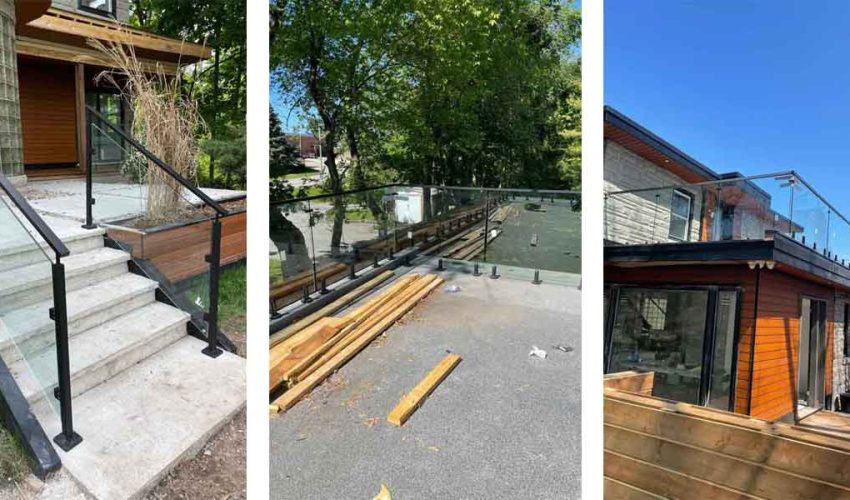
What is Glass Railings?
Glass railings are structures made of glass panels used to create a barrier or safety enclosure, often found in buildings, balconies, staircases, and decks. They are designed to offer a contemporary and minimalist look while providing safety and an unobstructed view. Glass railings can be framed or frameless, with various mounting options such as spigots, clamps, or channels. They are made from tempered or laminated glass for enhanced strength and safety. In addition to their aesthetic appeal, glass railings are easy to clean and maintain, making them a popular choice in modern architecture.

Glass railings offer several benefits for homeowners
1. Aesthetic Appeal: Glass railings provide a sleek, modern look that can enhance the overall design of your home. They create an open and airy feel, allowing natural light to flow through and maintaining unobstructed views.
2. Safety: Made from tempered or laminated glass, these railings are designed to be strong and durable. They provide safety without obstructing visibility, making them ideal for balconies, staircases, and around pools.
3. Low Maintenance: Glass railings are relatively easy to clean and maintain. Regular maintenance usually just involves wiping down the surfaces to remove dirt and grime, making them a practical choice.
4. Versatility: Glass railings can be customized to fit a variety of architectural styles, from contemporary to traditional. They can be used in both indoor and outdoor settings, offering flexibility in design.
5. Increased Property Value: Installing glass railings can enhance the perceived value of your home. Their modern look and safety features can be attractive to potential buyers.
6. Wind and Noise Reduction: While glass railings create a clear view, they can also act as a barrier against wind and noise, providing a more comfortable outdoor experience.
7. Durability: High-quality glass railings are built to withstand the elements, including UV rays, moisture, and temperature fluctuations, making them a long-lasting option for homes.
Overall, glass railings can be a practical and stylish addition to any home, offering both safety and beauty..
Here’s a FAQ section for glass railings:
Glass railings are typically made from tempered or laminated glass, which provides strength and safety. These materials are designed to withstand impact and harsh weather conditions.
Yes, when properly installed, glass railings are safe. They meet stringent safety standards due to their strong materials and secure installations. Always ensure that your glass railings comply with local building codes.
Maintenance is easy; simply clean the glass with a gentle glass cleaner to remove dirt and fingerprints. Regular cleaning helps maintain clarity and appearance. Avoid abrasive materials to prevent scratches.
Yes, glass railings are suitable for outdoor use. Ensure that the glass is treated for weather resistance, as high-quality tempered glass can handle exposure to the elements.
Framed glass railings have a supporting framework visible, while frameless designs have no visible supports, offering a more seamless look. Both options provide safety and aesthetics; the choice depends on your style preference.
The cost of glass railings can vary based on factors such as the type of glass, design complexity, and installation labor. It’s best to get quotes from multiple suppliers or contractors to find one that fits your budget.
Yes, glass railings can often be customized in terms of size, thickness, and even the type of glass (such as frosted or tinted) to suit your specific design requirements.
While glass railings do not typically offer privacy, options like frosted or tinted glass can increase privacy without compromising light flow.
Yes, glass railings can be used outdoors. It’s important to choose tempered glass designed for outdoor conditions, as well as corrosion-resistant hardware to withstand the elements.
Installation of glass railings should ideally be done by a professional to ensure safety and compliance with building codes. The process typically involves secure mounting of the glass panels and proper anchoring to withstand pressure.
